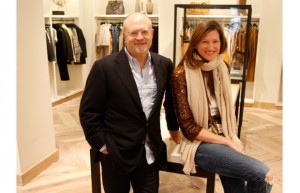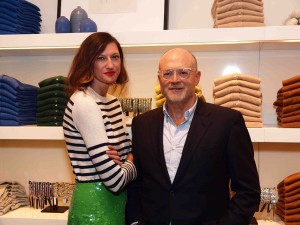The Big Mo Relationship!
Everyone the least interested in the fashion business knows the story of the spectacular renaissance of American ready-to-wear brand J.Crew, largely attributed to the strategy of CEO Mickey Drexler and his president and creative director Jenna Lyons.
We like to write about people, and most of all people who continue their quest through rain and storm. But behind the individual accomplishment, these stories often reveal the importance of certain relationships. Often, there are one or two persons in the shadows without whom the achievements would not have been possible. Whose support in one way or another contributed an indispensable ingredient to the alchemy of success.
We are therefore happy to present a biography of a relationship. A relationship which, as exceptional as it may be, proves the important part human chemistry can have in the creation of wealth.
Drexler came to J.Crew in 2003, after a rocky career at Gap. After having contributed to the brands success, the strategist was attributed its failure, left the outfit and came to Crew as a man who had a lot to prove. The company was in a bad state at the time. The once leader of preppy ready-to-wear had, with changing vogues, lost its consumers to more pertinent brands like Gap and Abercrombie and found itself in a crisis of identity. The company was ruled by merchandising consultants trying to retrieve success through dictating designing formulas to the in-house creatives. “A dark time” as long-time employee Lyons would say later.
Drexler allegedly attacked the problem from a personnel perspective, gathering the staff on his first day and telling them they were “interviewing for their job”. Many would leave, but Jenna Lyons would become one of the winners. The winner. Having been with the company since she left Parson’s at 21, she had worked her way up to head of women’s wear at the time. Now, on Drexler’s second day, she found herself in a room with the whole staff and her new boss ordering her to tell what she thought of the collection. It was a test of candour, and she chose to be frank. Garment after garment was selected either to stay or go to the bin, whether it was a seller or not. This test would define Drexler’s design strategy: put creative decisions in the centre of the business. And also: trust Lyons’s instincts.
They are a intriguing couple, the 69-year old restless businessman from Bronx and the 45-year-old glamorous and famed Californian designer. But the fact is that their collaboration, where Lyons has risen from designer to creative director to president and has been given relatively free rains to execute her strategy, has paid off. Under their rule, the company has conquered a whole new target group of young, urban buyers without renouncing the company’s core values. Income and profits are back on track. The brand has been hyped by the seduction of aficionados like Michelle Obama and Anna Wintour. In the process, Lyons has obtained a near to rock star status, her slightly tumultuous private life adding to the celebrity.
Drexler can be seen as loyal and supporting to his protégé, but above personal sympathy and trust in Lyons’s designer acumen, he has been capable to discern and develop the business qualities of the effervescent creative and give her all the freedom needed also in this field. Decisions related to Lyons’s complete branding overhaul of the company have not come for free and must have been controversial in the early, meagre days. It must have taken a serious dose of confidence and vision by Drexler to follow this path, all the more exceptional in a cold-feeted business climate where quick profit and the cutting-back of costs were the rule.
To say the least, Drexler’s actions were unorthodox. So what gave him the determination and belief to put J.Crew on the right tracks, and how did he persuade the shareholders?
Creator of the Apple retail stores, Drexler was not at his first trial, though. He understood the crucial importance of innovative design and had already experienced success with original and criticised methods (one 2001 title in Business Week was “Here’s why Apple stores won’t work”…). So when Lyons set out to make the brand a prestigious and coherent one, may it be online, in the catalogue or in the retail stores, her mind was in the same tracks as Drexler, and the latter had the savvy to back it up. The two of them confers the same importance to their mission: it is not just about creating a money-making production and distribution, it’s about creating an environment of beauty, simplicity and quality that people feel good being in. With time, they have proved the commercial pertinence with this thinking, but there is, beneath it all, an attraction to things well made which drive the couple to invest in the long term, consciously building the reputation of the company brick by brick. As Drexler said to one small producer hesitant of working with the “big” J.Crew: “we are trying our best to behave like a tiny company”.
It is rare for a designer and creative director to have the freedom and influence that Lyons has. Innovative design and strategy is too often assassinated in the cradle, and even more so in big companies that have the financial capability to back them up. As says venture capitalist Ben Horowitz of Andreessen & Horowitz: “Big companies have plenty of great ideas, but they do not innovate because they need a whole hierarchy of people to agree that a new idea is good in order to pursue it. If one smart person figures out something wrong with an idea — often to show off or to consolidate power — that’s usually enough to kill it.” And few creatives have decision power in big companies. The original constellation Drexler-Lyons and the balance between finance and creative priorities in the decision-making have paved the way for J.Crew’s success, yet few are the companies that will be able to follow their example.
The success of Lyons’s and Drexler’s relationship is based on a rare mutual comprehension, in itself due to the fact that both have a little bit of the other one’s qualities: the business strategist Drexler understands and takes interest in the creative process, the creative Lyons has proved to have her fair share of pure business acumen and a global view of the company. This fact assures a great deal of mutual confidence. Also, both of them having worked their way up the ladder with astuteness and attention, they know when to tiptoe and when to be forthright with one another. It is probably Lyons who manages this part more than Drexler, though. Used to handle sensitive creatives with an insightful mix of care and determination, she is said to be one of very few people who knows how to sort Drexler’s constant flow of ideas and to win him over when he is not in the mood.
A part from the mutual understanding, there seems to be a fair share of pure pragmatism behind the success of the Drexler-Lyons collaboration: they both understand that they can create things together that they cannot do alone, they know that success cannot be obtained with half-measures and they know that they – and others – will fail from time to time in the process. And both are people unafraid of exposure, leading with a self-unconsciousness said to be at the same time demanding by its frankness and inspiring by its naturalness.
So what can be learned, if need be? Well, maybe that two are stronger than one and that mutual confidence can be a real value in a company, not only for greasing the wheels, but also for driving innovation – and even re-imagining a whole business. Because, to innovate and engage, we need the confidence to be a little bit more ourselves, to step out of the narrow role that has been assigned to us and to use our personal, private resources. This is what Jenna Lyons did on Drexler’s second day and why she was chosen to stay
Of course, you would need a boss like Drexler.



























